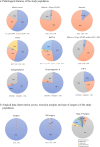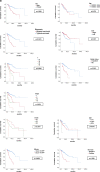Prognostic significance of laterality in lung neuroendocrine tumors
- PMID: 35301675
- PMCID: PMC9156515
- DOI: 10.1007/s12020-022-03015-w
Prognostic significance of laterality in lung neuroendocrine tumors
Abstract
Purpose: Well-differentiated lung neuroendocrine tumors (Lu-NET) are classified as typical (TC) and atypical (AC) carcinoids, based on mitotic counts and necrosis. However, prognostic factors, other than tumor node metastasis (TNM) stage and the histopathological diagnosis, are still lacking. The current study is aimed to identify potential prognostic factors to better stratify lung NET, thus, improving patients' treatment strategy and follow-up.
Methods: A multicentric retrospective study, including 300 Lung NET, all surgically removed, from Italian and Spanish Institutions.
Results: Median age 61 years (13-86), 37.7% were males, 25.0% were AC, 42.0% were located in the lung left parenchyma, 80.3% presented a TNM stage I-II. Mitotic count was ≥2 per 10 high-power field (HPF) in 24.7%, necrosis in 13.0%. Median overall survival (OS) was 46.1 months (0.6-323), median progression-free survival (PFS) was 36.0 months (0.3-323). Female sex correlated with a more indolent disease (T1; N0; lower Ki67; lower mitotic count and the absence of necrosis). Left-sided primary tumors were associated with higher mitotic count and necrosis. At Cox-multivariate regression model, age, left-sided tumors, nodal (N) positive status and the diagnosis of AC resulted independent negative prognostic factors for PFS and OS.
Conclusions: This study highlights that laterality is an independent prognostic factors in Lu-NETs, with left tumors being less frequent but showing a worse prognosis than right ones. A wider spectrum of clinical and pathological prognostic factors, including TNM stage, age and laterality is suggested. These parameters could help clinicians to personalize the management of Lu-NET.
Keywords: Ki67 index; Lung neuroendocrine tumors; Mitotic count; Necrosis; Prognostic factors.; Tumor location.
© 2022. The Author(s).
Conflict of interest statement
The authors declare no competing interests.
Figures





References
-
- WHO Classification of Tumors Editorial Board. Thoracic tumours. 5th edn. (International Agency for Research on Cancer World Health Organisation, Lyon, 2021).
-
- Caplin ME, Baudin E, Ferolla P, Filosso P, Garcia-Yuste M, Lim E, et al. Pulmonary neuroendocrine (carcinoid) tumors: European Neuroendocrine Tumor Society expert consensus and recommendations for best practice for typical and atypical pulmonary carcinoids. Ann. Oncol. Off. J. Eur. SocMed. Oncol. 2015;26(8):1604–1620. doi: 10.1093/annonc/mdv041. - DOI - PubMed
MeSH terms
LinkOut - more resources
Full Text Sources
Medical
Miscellaneous

